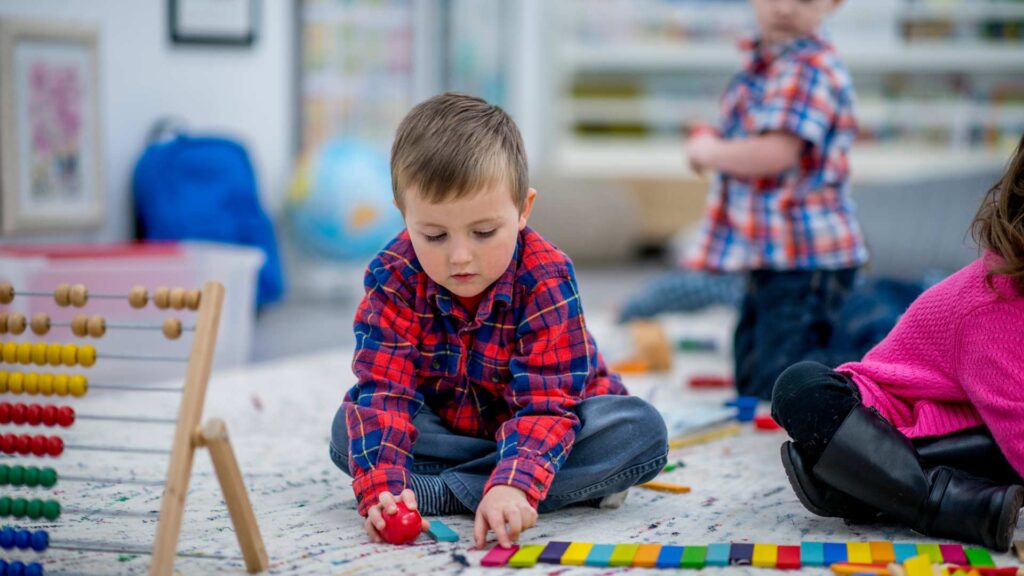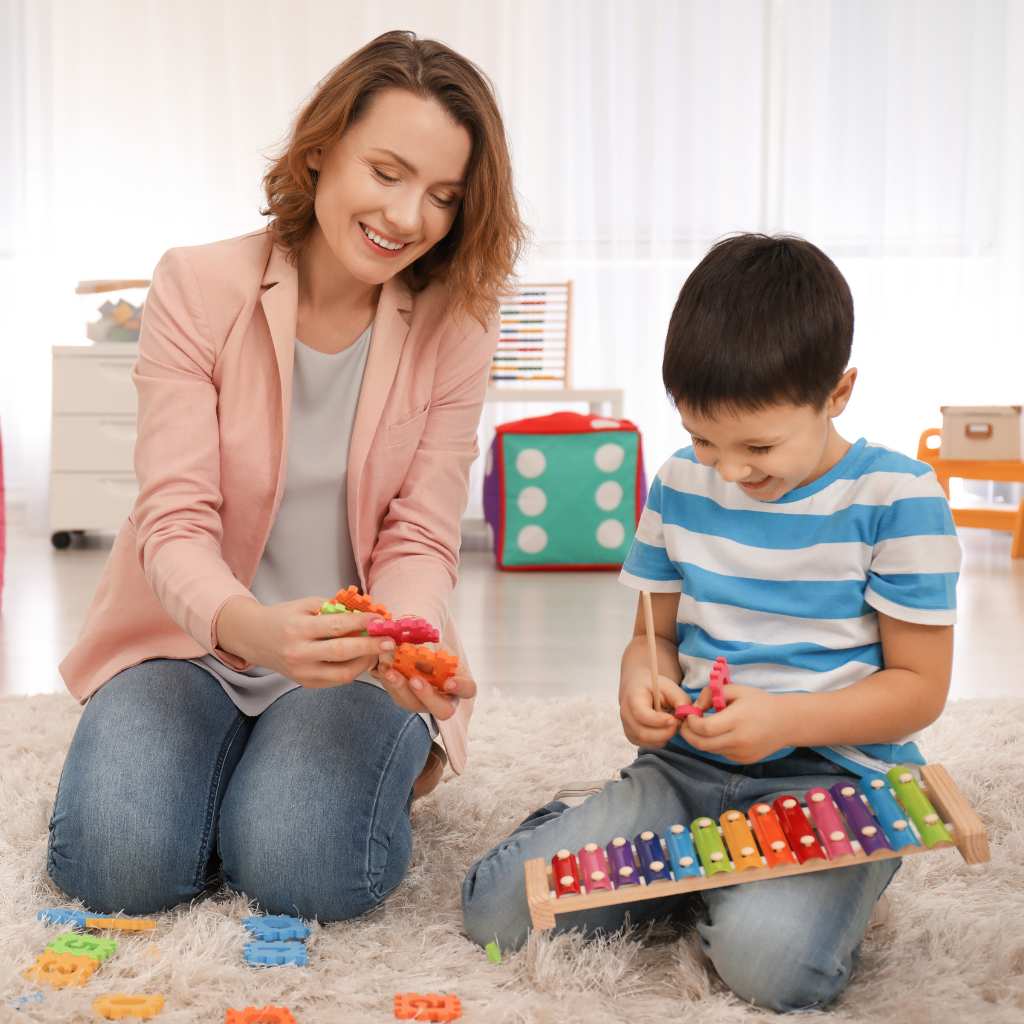Table of Contents
Why is play important in the development of my child with autism?
Play is a vital tool for all children, but for children with autism, it plays an even more significant role. Beyond just fun, play in autism helps children explore the world, develop communication skills, and learn how to connect with others. However, play may not always come naturally or easily to them, which can sometimes lead to frustration or concern.
So, why is play important in the development of my child with autism? Play serves as an essential tool for expression, communication, and participation in the world for children with autism. Despite the challenges, it is a skill that caregivers should actively support and promote.
In this blog from ABA Centers of Virginia, we will explore how you can help your child use play as a tool for growth and connection and how play-based ABA therapy can boost developmental achievements. Keep reading to discover how encouraging play in autism can open new doors in your child’s life!
How Does Play in Autism Look Like?
Play in children with autism often looks and feels different compared to the play of neurotypical children. These differences are not a sign that something is “wrong” but reflect a different way of interacting and learning.
Many children with autism prefer activities that involve repetitive patterns, such as ordering objects or repeating sounds. They often like to play alone and may seem less interested in games that involve direct social interaction, such as role-playing. Instead of playing “house” or “grocery store,” they may focus on organizing their toys or seeing how the mechanisms of objects, such as wheels or levers, work.
For some parents, these differences can be disconcerting. However, understanding these particularities allows us to respect their interests and find ways to turn those same activities into opportunities for significant skill development.
The Challenges of Play in Autism
Play, which for many children is an intuitive activity, can present a number of challenges for children with autism. Social interaction, communication, and sharing are challenging concepts for them to understand and implement, mainly when play depends on cooperation or reading the facial expressions and emotions of others.
Some common challenges of play in autism include:
- Difficulty engaging in imaginative or pretend play: These types of play require understanding roles and using imagination, skills that are often complex for children with autism.
- Specific interests: When a child shows great interest in a single topic or type of activity, it may require effort to motivate them to explore other forms of play.
- Need for clear structures: Many children with autism are more comfortable with an established routine and clear rules, which is sometimes not possible in free play.
- Social interaction: Play in autism can be solitary due to difficulties in interacting, reading social cues, sharing, or taking turns.
- Sensory needs: Some children with autism may feel overwhelmed in environments with loud sounds, bright lights, and certain textures.
How to Promote Play Skills in Children with Autism in 6 Steps
Parents and caregivers have an essential role in helping children with autism develop their play skills. Here are some strategies you can implement to promote more diverse and enriching play in autism:
- Incorporate your child’s favorite objects: If your child enjoys trains or blocks, use those objects to teach new skills. For example, you can make a tower together, taking turns to work on cooperation.
- Start with games your child enjoys: Identify what kinds of games your child enjoys and develop activities around them. If they like to line up cars, you can create a game where those cars have to “get to a goal” to encourage following directions.
- Model the game: Play along with your kid and show them how to interact. If they are building a tower of blocks, build one too and then suggest combining them to make a larger structure.
- Use play routines: Establishing specific times and precise ways to play can help your kid know what to expect and feel more confident to interact. Incorporating play into the routine can make them feel less intimidated and more open to participating.
- Reinforce small accomplishments: Use positive reinforcement to motivate your child to participate in play. Celebrating each small step they take in the direction of playing more collaboratively can make a big difference.
- Take advantage of sensory play: Games that stimulate the senses (such as play dough or water play) can be especially appealing to children with autism. Not only are these games fun, but they also help regulate their sensory system, something that is important for many children on the spectrum.
Supporting Play in Autism with Play-Based ABA Therapy
ABA (Applied Behavior Analysis) therapy is a valuable tool for skill development in children with autism, and many of its sessions may include elements of play.In these sessions, therapists use play to help children develop communication skills, take turns, and manage emotions.
According to studies published in the National Library of Medicine, incorporating play into the development of children with autism can offer many valuable benefits, mainly when using play-based interventions.
Here’s how different types of play, including those with new technologies and symbolic play, can help children with ASD:
- Improves communication: Symbolic play with toys (like dolls or animals) helps children practice social interaction and language skills in a fun, natural way.
- Enhances social skills: Technology-based play, such as motion-sensing games or virtual worlds, encourages turn-taking, cooperation, and social engagement, improving social behavior.
- Boosts cognitive and motor skills: Interactive games strengthen attention, memory, and motor skills through structured, engaging tasks.
- Encourages emotional regulation: Play helps children manage emotions, offering opportunities to learn how to respond to different feelings in a safe environment.
- Strengthens parent-child interaction: Parent-involved play programs teach techniques to improve bonding and communication, supporting emotional connections.
- Provides structured learning: Structured play routines, including board games and digital games, teach essential life skills in a consistent, predictable way.
The focus of play-based ABA therapy is on children learning without feeling pressured. It is a form of “disguised work” that allows children to practice necessary skills in a safe and positive environment. Parents can also participate in these sessions by learning how to implement play strategies at home.
ABA Centers of Virginia and Play-Based ABA Therapy
Play in autism is a transformative tool. Not only does it strengthen the bond with your loved one, but it also provides a platform for learning and self-expression. While the challenges can be significant, there are many ways to support our children in this process by tailoring play to their unique needs and interests. Let’s remember that each child has their own pace, and the most important thing is to celebrate each small step forward.
If you would like to explore play therapy for autism more or have specific questions, feel free to contact ABA Centers of Virginia by calling (855) 957-1892 or connecting online. The journey may seem long, but every moment shared in play is a step forward toward enriching development and a life with meaningful experiences.










